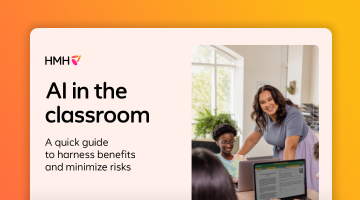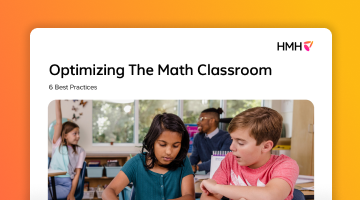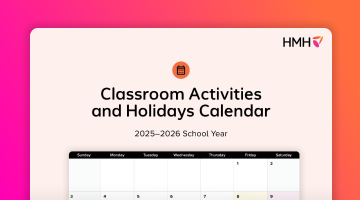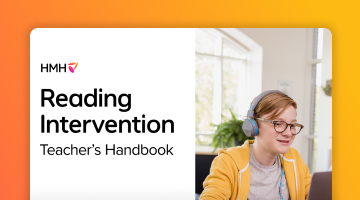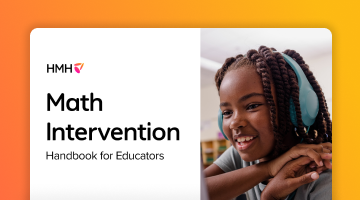
Reading scores for Connecticut's New Haven Public Schools reached what officials called a “crisis.” Three years later, the numbers are starting to turn around.
“The data is showing that we’re growing in all grade levels since we’ve implemented HMH,” says Keisha Redd-Hannans, assistant superintendent of curriculum instruction and assessment for New Haven Public Schools. “Our students are on track to have more than one year’s growth and that’s exciting.”
K–12 students’ ELA proficiency scores on the end-of-year standardized test edged up from 22.1% in the 2022–23 school year to 23.4% in the 2023–24 school year.* Education leaders in New Haven acknowledge that this is only a slight increase, but they see it as a harbinger of increased gains to come, especially since interim assessment data shows students are on the right track.
The improvements followed the adoption in 2023 of these HMH literacy solutions:
- HMH Into Reading with ¡Arriba la Lectura! (Grades K–6)
- HMH Into Literature (Grades 6–12)
- Writable (Grades 3–12)
- Read 180 intervention program (Grades 3–12)
- NWEA MAP Growth reading assessments (Grades 3–10)
“We noticed our students’ vocabulary started to expand, their writing improved, and teacher quality improved at the same time, and this was in a short, two-and-a-half-month pilot,” says Redd-Hannans.
Interim data shows students making steady progress
NWEA MAP Growth reading assessments given throughout the school year show New Haven students are learning at a healthy pace. Of 9,103 students who took beginning-of-year and end-of-year MAP Growth assessments in the 2024–25 school year:
- More than one-third of students (36%) made 1.5 times more progress than what is typically expected for their grade level, based on national norms
- Half reached 100% of “typical growth,” meaning they are right on track with learning expectations
- 92% achieved at least the average amount of growth students usually make in a year, indicating solid progress toward learning goals
Kenneasha Slolely, principal at Conte West Hills Magnet School, has noticed that students are starting to feel more confident.
“To see the growth that they’ve made from point A to point B, C, D—that does a lot for the students’ self-esteem and belief in themselves,” says Sloley. “They set goals and now they can say, ‘This is attainable and I did this in a short amount of time. Look at what I have achieved.’”
of students made 1.5 times more progress than typically expected for their grade level
achieved “typical growth,” meaning they are right on track with learning expectations
achieved at least the average amount of growth students make in a year, indicating solid progress
Setting the district up for continued reading growth
Redd-Hannans says she and fellow education leaders knew that in order to move students forward after years of stagnated reading scores, the district would have to adopt a program rooted in the science of reading.
Yet some in the district were reluctant to make the switch to a new curriculum. “It was a fight, says Redd-Hannans. “But we remained steadfast that we needed it, and we would let the data speak for us.”
The new literacy approach requires teachers to spend more time in the early grades on phonics instruction, which research shows most kids need to read well. This includes a 90-minute literacy block for Grades K–3 that breaks down to 30 minutes of phonics, 20 minutes of whole-group structured literacy instruction, and 40 minutes of small-group instruction.
Another priority was to provide a consistent curriculum for all grade levels. Before the integration of HMH programs, students in the same grade could have been learning entirely different lessons from one school to the next. Now everyone can access the same curriculum—whether it’s reading, writing, intervention, or assessment—in one place.
“Everything is just in one neat package,” says Jennifer Tousignant, supervisor of elementary reading and language arts. “We can tie it with a bow, and it makes life much easier when other things in education are often not so easy.”
Unlocking student potential with MAP Growth
Hear what New Haven educators have to say about how MAP Growth assessments give them the data they need to personalize instruction, support diverse learners, and track meaningful student progress.
Keisha Redd-Hannans: “As we look at that growth, we're also pinpointing the skills that our students need, and how we can deliver instruction to best meet their needs.”
Jennifer Swingler: “It's not just about that differentiation model. It's more about how we are scaffolding and building kids up to be able to reach that grade level text.”
Jennifer Tousignant: “Our HMH partners do a data review with us, which is always insightful because they will ask some questions that we haven't thought of.”
Coaching is key to successful program implementation
Educators in New Haven point to teacher coaching as a critical key to successfully implementing their new literacy program. They started off with an in-person HMH literacy coach who did walkthroughs, answered teachers’ questions about the new programs, and provided actionable feedback. They also use HMH Coachly, a year-round subscription for teachers that provides unlimited support from instructional coaches.
“The student and teacher materials are great,” says Tousignant, the supervisor of elementary reading and language arts. “But we understand that a program is only as good as the teacher who’s using that program. So we invested in coaching to better meet the individual needs of teachers with different skillsets and experience levels.”
Nancy Rose, instructional literacy coach at Conte West Hills Magnet School, says she would have been overwhelmed without the help of an HMH coach who knows the programs inside and out and can easily guide implementation.
“She knows our school, she knows me, she knows the teachers, she knows our areas of growth,” says Rose. “When teachers ask me questions, and I don't know the answer or can't find the answer, I know I have someone to rely on to help me.”
Lia Saulino, a second-grade teacher at Conte West Hills Magnet School, appreciates having someone to turn to when she has questions about the program, interpreting student data, or how to improve a lesson.
“My coach and I work together hand in hand,” says Saulino. “If I have a question, she’s readily available. That makes a huge difference for my instruction and helping my students grow.”
A path to excellence for New Haven students
Five years from now, says Superintendent Madeline Negrón, New Haven educators will look back on how a whole community—teachers, students, families, grandparents, business owners, religious leaders—came together and rallied behind children. Negrón refers to these five years as “the path to excellence.”
“We’ll be able to see how far we’ve come,” she says. “But we’re not only going to speak about the numbers. We're going to sit back and think about the lives that we impacted. Kids were seen, kids were heard, and kids knew that they belonged because we gave them a chance.”
Read more about New Haven's success in the downloadable below.

*End-of-year standardized test scores are not yet available for the 2024–25 school year, but they’re trending in the right direction, according to district officials. We’ll update the post when the scores are released.
***
Learn more about our science of reading curriculum, an evidence-based approach to help students in their reading journeys.
Be the first to read the latest from Shaped.

